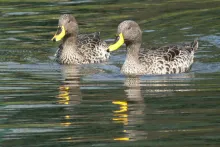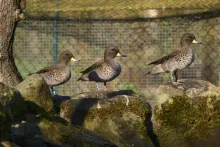
Yellow-billed Duck (Anas undulata)
Species name
- Dutch name:
- Geelsnaveleend
- English name:
- Yellow-billed Duck
- German name:
- Gelbschnabelente
- French name:
- Canard à bec jaune
- Scientific name:
- Anas undulata
Scientific classification
- Order:
- Anseriformes
- Family:
- Anatidae
- Onderfamilie:
- Anatinae
- Genus:
- Anas
Description
- Description:
African yellow billed Duck (Anas undulata undulate)
Male:
Head and neck blackish grey with pale streaking, upperparts and underparts dark brown with pale feather edges. Wing has secondaries iridescent green, bordered in black and with white feather tips. White tips also to dark grey greater coverts (speculum green bordered with black and white).Female:
Are almost identical in appearance to males except for a somewhat duller feather and. has paler yellow splotchy bill coloration and a slightly smaller size.Juvenile:
Looks like adults but more duller over all, darker on head and appears more spotted then mottled on underparts.Abyssinian yellow billed duck (Anas undulata ruppelli)
Male:
Darker (narrower pale feather edging), secondaries iridescent blue rather than green. The bill is bright yellow, black stripe down culmen (not reaching end of bill), black nail and cutting edges.Female:
Are almost identical in appearance to males except for a somewhat duller feather and. has paler yellow splotchy bill more yellow-orange. and a slightly smaller size.Juvenile:
Looks like adults but more duller over all, darker on head and appears more spotted then mottled on underparts.
- Behaviour:
Yellow-billed Ducks mix freely with other species of water fowl, there is concern about the fact that there are several authenticated records of their hybridizing with Mallard Ducks which have been allowed to escape into the wild.
Standard Measurements
- Body Length (cm):
- The male (drake) of the Yellow-billed Duck measures approximately 51-58 centimeters. The female measures approximately 51-58 centimeters.
- Body Weight (grams):
- The male will weight about 312-510 gram. The female will weight about 312-510 gram.
The weight is notoriously variable and can only be used as indication!
- Subspecies:
There are two subspecies:
- Anas undulata undulate - African yellow billed Duck
- Anas undulata ruppelli - Abyssinian yellow billed duck
- Note:
Dabbling Ducks are generally hardy, easy to maintain and easy to breed. Shelter may be required by some of the smaller species in winter. They should be provided with cover (including marginal pond cover) and loafing areas as well as water. A pen which is 50% water is suggested. The water may be shallow (i.e. no more than two feet deep is required), and muddy areas for dabbling in are also appreciated. These ducks are generally good in mixed collections, although the smaller and quieter species may be bullied. Territorial disputes between ducks of the same species may be avoided by keeping only one pair of each species in an enclosure, unless the area is very large. For a single pair of ducks a pen are of 50 to 100 square metres, depending on the size of duck, should be provided.
Most species are ground nesters and both close ground cover and ground level nest boxes should be provided. Hand-rearing is generally preferred, as these ducks are generally poor parents in captive conditions, particularly in enclosures shared with other waterfowl. These ducks are prone to hybridization, particularly with closely related species, which should be kept apart from one another.
Yellow-billed ducks are hardy and not difficult to keep. Cover and loafing areas should be provided as well as water.
These ducks are easily bred and prolific; they may use natural cover or a nest box for nesting, and favour islands. Usually lay April to June.
Readily hybridise with closely-related species and should be maintained separately from such species. Hybrids also have been reported with Rosy-billed pochard (Netta peposaca), Red-crested pochard (Netta rufina) and Wood duck (Aix sponsa).
- Breeding:
- The female Yellow-billed Duck usually lays from 4-12 creamy to yellowish buff eggs and incubates them for 27-29 days.
- Artificial incubating:
The ideal relative humidity for incubating most waterfowl eggs is 55% (ground nesters) and 40% (cavity nesters). The temperature is usually 37.4°C. Set ventilation as recommended by the incubator manufacturer. Eggs must be turned, either automatically or by hand, a minimum of 4 times a day. As the duckling develops there is a loss of water from the egg and the air sac gets bigger. In normal development of an egg with a 27-29 days incubation, the air sac occupies about a third of it three days earlier. Cleanliness is vital and ideally eggs should be moved to a separate hatcher at this point, where the humidity should be increased to 65% and even higher once they have pipped internally.
- Bird banding:
- Recommended closed leg band ring size for the Yellow-billed Duck is 12 mm.The leg band ring can only be applied on a young dabbling duck at around 12-14 days old.
- It doesn't matter what leg that you band, but it's good to have a consistent system. Suggested: Left leg = Female, Right leg = Male
- Rearingfeed:
-
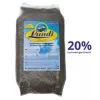
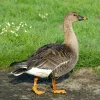

Floatable special rearing feed for all types of aquatic ornamental fowl - especially for the cultivation of trees as well as greening ducks.
This well-balanced complete feed with 20% protein content convinces above all by its good compatibility and forms the basis for visibly healthy growth from day one.
Made exclusively from wholesome and selected raw materials, Lundi Micro Regular is also ideally suited for the year-round feeding of waterfowl.
- Maintenance food:
-


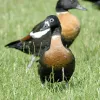


Floating full food for all sea ducks, green ducks, eider ducks and geese, especially in the moulting and breeding phase ideally suited. Packed with wholesome raw materials, natural vitamins and trace elements, this performance food with a protein content of 30% forms the basis for lifelong vitality.
